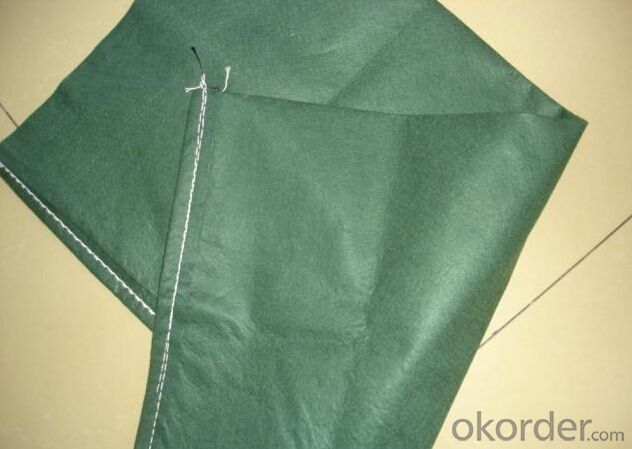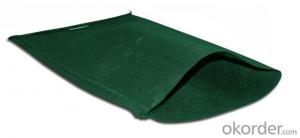Fibre Geotextile PP Geotextile Bag, Sand Bag, Slope Protection
- Loading Port:
- China main port
- Payment Terms:
- TT OR LC
- Min Order Qty:
- 3000 pc
- Supply Capability:
- 300000 pc/month
OKorder Service Pledge
OKorder Financial Service
You Might Also Like
1,Brief Introduction of PP Geo Textile Bag
color:white,black,deep green,grey,etc
Size:60cm*45cm,85cm*45cm,95cm*35cm,103cm*70cm,110cm*50cm,etc
2,Feature of PP Geo Textile Bag
Strong corrosion resistance ,UV resistance, anti-aging, non-toxic, non-combustion,good stability,split not extend etc. features.Anti-rot,anti-degradation,pests erosion resistance.
3,Application of PP Geo Textile Bag
1).Ecohydraulic Engineering:
Natural environment for both sides of the ecological river, soil and water conservation,reservoir fluctuation zone regreening, wetland project, coastal engineering etc.
2.)Highway Engineering:
Roadbed side slope,retaining wall project, massif excavate side slope,bridgepier slope protection,culvert exits and entrances "Eight word" wall,sound protective screen, ecological isolation strip,swelled ground side slope,freeze thawing district side slope etc.
3).Railway Engineering:
Roadbed side slope,retaining wall project, massif excavate side slope,bridgepier slope protection,culvert exits and entrances "Eight word" wall,ecological beauty spot ecological district side slope,ecological fragile district ecological side slope etc.
4).Municipal garden engineering:
Massif regreening,massif excavate side slope,urban center ecological river bank,pack lakeshore,puente hills landfill,mine regreening,golf course,gardening landscape wall,
saline-alkali soil side slope etc.
4.FAQ
We have organized several common questions for our clients,may help you sincerely:
1>How about your company?
A manufacturer & supplier focuses on the production of geo textile and geo bag etc. We have exported this product to Amereica, Europe and South East Asia. Customized product is also available based on your detailed requirements.
2> What's the MOQ ?
We kindly recommend 1x40'HQ as the price would be economical based on large loading quantity.


- Q: How do geotextiles help with sediment control in construction sites?
- Geotextiles help with sediment control in construction sites by acting as a barrier to prevent soil erosion and the migration of sediment. They are placed on the surface of the soil, where they allow water to pass through while trapping sediment particles. This helps to retain the soil in place and prevent it from being washed away by rainwater or other erosive forces. Geotextiles also aid in filtration by capturing suspended particles and allowing clean water to drain through, thus preventing sediment-laden runoff from reaching nearby water bodies.
- Q: What are the main functions of geotextiles?
- The main functions of geotextiles are to provide separation, filtration, reinforcement, and drainage in various civil engineering applications. They help prevent the mixing of different soil layers, enhance soil stability, control erosion, and allow for the efficient flow of water.
- Q: Geotextile manufacturers rely on what to do a hundred years do not rot geotextile
- Because geotextile raw materials are chemical fiber. Huazhi geotextile material answer
- Q: What are the advantages of using geotextiles in green building design?
- Geotextiles offer several advantages in green building design. Firstly, they help in erosion control by preventing soil erosion and protecting the surrounding environment. Secondly, geotextiles act as a filtration system, promoting water drainage while retaining fine particles, thus enhancing water quality. Additionally, they provide stability and reinforcement to the soil, ensuring the structural integrity of the building's foundation. Geotextiles also aid in weed control by preventing the growth of unwanted vegetation. Lastly, these materials are often made from recycled materials, making them an eco-friendly choice for sustainable construction practices.
- Q: Are geotextiles suitable for use in geotextile tube dewatering systems?
- Yes, geotextiles are suitable for use in geotextile tube dewatering systems. Geotextiles are commonly used in these systems to provide filtration and separation of water from solids. They allow water to pass through while retaining the solids, making them an effective solution for dewatering and sediment containment projects.
- Q: How do geotextiles improve the performance of sports fields?
- Geotextiles improve the performance of sports fields by providing effective drainage, preventing soil erosion, enhancing stability, and increasing durability.
- Q: How do geotextiles contribute to land reclamation projects?
- Geotextiles play a crucial role in land reclamation projects by providing soil stabilization, erosion control, and drainage solutions. They are used to separate and reinforce different soil layers, prevent soil erosion caused by water flow, and promote vegetation growth. Geotextiles effectively control sediment migration, improve soil quality, and enhance the overall stability and sustainability of reclaimed land areas.
- Q: In the cofferdam construction process, geotextile materials after entering the need to arrange sampling test? Is there a specification? If the arrangements for testing, is to do physical experiments, or do chemical experiments, or do? More
- Physical experiments,
- Q: Do you want to put the geotextile and the impounded vegetables in the soil?
- No poison, you can rest assured that use. Geotextile raw materials are PET or PP, and the production of mineral water bottles of raw materials the same, without any side effects. Water storage board is the raw material is HDPE plastic. There is no harm to people. Geotextile and water storage board is mainly used in the roof garden or underground garage roof green. It is possible to store rainwater and protect the concrete at constant temperature. , Has been widely used in developed countries. At present the country is developing urban sponge project, the application of water storage board will be more extensive.
Send your message to us
Fibre Geotextile PP Geotextile Bag, Sand Bag, Slope Protection
- Loading Port:
- China main port
- Payment Terms:
- TT OR LC
- Min Order Qty:
- 3000 pc
- Supply Capability:
- 300000 pc/month
OKorder Service Pledge
OKorder Financial Service
Similar products
Hot products
Hot Searches
Related keywords




























